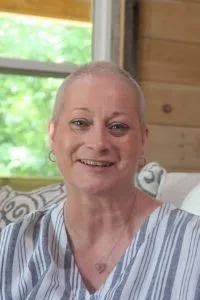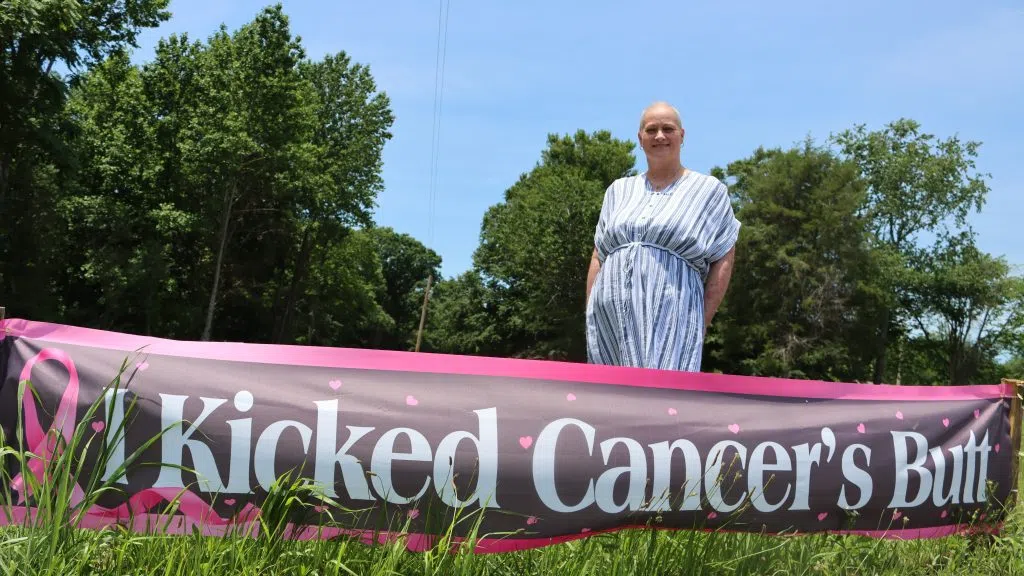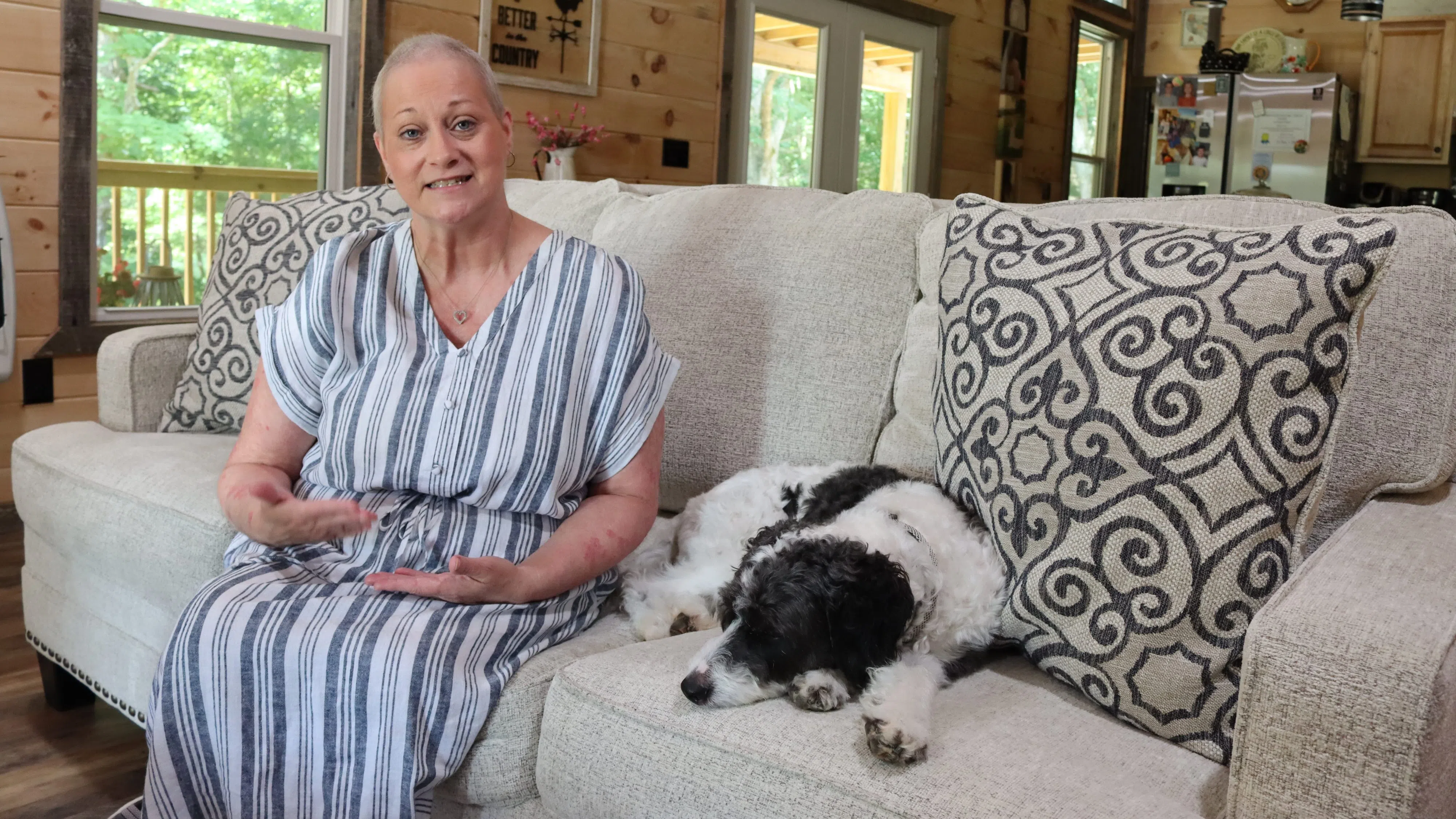By MELINDA J. OVERSTREET
for Glasgow News 1
Frankie Comer may have sensed something his human mother didn’t know, but whether or not that was the case, ultimately, the golden doodle puppy was the reason she discovered a tumor on her breast.
Melissa Comer, now 54, was due for her annual mammogram in January 2023 but canceled it because she had the flu. Life was happening and she hadn’t gotten around to rescheduling.
“So here comes August …,” she said. “We had got done with breakfast that morning and I was at the kitchen sink, and he wanted some love and attention, and I bent down to love on him. And my arm brushed across my breast and I felt the lump with my arm.”
She said that even before that, he always sat to her right side, and he’d lay his head right there and sniff her in that area.
Comer, who lost both of her parents and “a lot” of other family members to cancer, called her husband to come out of the bathroom and asked him whether he felt something there. He did.
And with a phone call to her family doctor, her “roller coaster” ride began.
A mammogram and ultrasound were ordered, with “suspicious” results; then came a biopsy, and confirmation of malignancy came a week later.
“I was diagnosed with Stage 2 invasive ductal carcinoma, which they call triple negative also,” Comer said, later explaining that that refers to negative hormone and HER2 (human epidermal growth factor receptor 2) tests.
At this point, it was Sept. 19, and the lump was about the size of a walnut, she said.
“It had broke out of my duct and come up toward my skin, and that’s how I felt it,” Comer said. “Otherwise, I would not have known until it was a later stage,” she said, perhaps when she may have gotten a mammogram in January of this year.
She opted to have that right breast removed rather than just the lump, and it was after that – Oct 11 – the stage of the illness was determined. They also found it in and removed a couple of nearby lymph nodes.
“Instead of letting my hair come out on its own, I went ahead and shaved it, Thanksgiving weekend. That was very emotional. My family was there, you know, with me, but that was very emotional,” she said.
She was supposed to have 16 rounds of chemotherapy. Beginning Nov. 29, she had four rounds of what is known as the red devil, spaced every two weeks. Then 10 doses of Taxol, spaced a week apart.
Each created misery for her in its own way.
“The red devil is one of the strongest chemos,” Comer said. “It was rough.”
She said it made her sleep, like four days a week. She couldn’t hold her eyes open. It also left her very weak, to the point she needed help getting out of bed and getting around.
“I got through those red devils and I started with the Taxol. Everyone said, ‘Oh, it’s not going to be as bad on you,’” she said. “My very first Taxol treatment, I had a bad reaction.”
Her heart started beating very fast, her throat and lips started closing and itching, but her nurse noticed quickly and they had to stop the treatment. After that, she started premedicating with a steroid the night before and then an antihistamine and additional steroid the next day prior to the Taxol treatment.
Taxol can cause neuropathy, and by the time she’d had 10 of those treatments, her neuropathy was so bad in her hands, legs and feet that the decision was made to discontinue them.
“By that time, I was like dropping my utensils even trying to eat,” Comer said. “I had no feeling in my fingers hardly at all. And so we decided we wouldn’t do the last two. My legs and my feet healed really quick; I’m still having some issues with the tips of my fingers, but it’s getting better.”
She had a month to recover from the chemo effects. Then came 28 radiation treatments – every day except Saturday and Sunday – starting May 2.
“Those were not as bad on me; I could handle those,” Comer said.
After 16 or 17 of those, though, she said, her fair skin started turning red and breaking out with burns, especially in the area where the treatment was focused.
“I’m healing from that still,” Comer said, “but other than that, the radiation was nothing compared to the chemo. I could handle that.”
Comer’s last radiation treatment was two weeks ago, and the burn splotches are still apparent on her limbs, and the treatment area itself is still red and tender.

Melissa Comer is just beginning to resume something like a normal life after completing the last of her cancer treatments two weeks ago. Melinda J. Overstreet / for Glasgow News 1
“All in all, I lost about 50 pounds,” Comer said. “I just lost my appetite. I still haven’t got my appetite all the way back.”
She said at least she can taste her food again.
“Everything tasted like metallic or cardboard, you know, there for a long time,” Comer said.
The main two exceptions to that, for whatever reason, were spaghetti and butterscotch milkshakes, she said.
Her hair started coming back recently, too, she said.
“It was like, one morning a couple of weeks ago, I woke up, and it was just like, overnight, someone had sprinkled Miracle Gro on my head!”
She had also lost her eyebrows and eyelashes, and they’ve come back well and fast, too.
She said she’s one of those people who seldom sat still, was always doing something and very energetic, and she’s definitely not back to her old self on that front yet.
“My biggest complaint right now … is I just don’t have my energy level back up. I think I’m fine and I will overdo it really fast and easy, and then I’m down for, still, a couple of days, just trying to recover from that,” Comer said. “Now I’m limited. I’ve got to get it into my brain that it will come back; it’s just going to take a little while.”
She said her doctor told her it could be two or three months after radiation was over before she really starts getting her appetite back and six months to a year before her energy levels return to normal.
Back to the beginning
Comer grew up in Gamaliel and lived there until about 2 and a half years ago, when, after the youngest of their four daughters got married, she and her high-school sweetheart and husband of 37 years decided to downsize and sold their home, and she retired at that point and has been watching some of her grandchildren whenever she could.
“That was my job, being a Mimi,” she said.
The couple moved to a friend’s property that was vacant while they looked for just the right spot upon which to have a custom “tiny home” constructed. It took a while to find the land they wanted but eventually it happened.
Then her illness interrupted that process for a while,
“We kind of put it off, on hold, when I was diagnosed with cancer,” she said. “We put it on hold until we found out and knew what to expect in the future.”
In March, her husband Terry started back into it while she was dealing with chemotherapy, and about a month ago, they moved into their new place in the Coon Foot area of Monroe County, and just this week, she’s felt better enough to start resuming her Mimi role as her energy picks up, “of going and running and doing for them, picking them up from school. That’s what I was doing.”
Comer said she always got her mammograms when she was supposed to before this and did breast self-exams as well, but she hadn’t noticed this lump at the side of her breast that had sort of separated until that day with Frankie, which she credits now for saving her life.
“Triple negative breast cancer is one of the hardest ones to treat and it’s got a really bad rate of coming back, and when it does come back, it normally comes back in your brain, your liver, your lungs ….,” she said.
That’s a big part of what led her to decide to have the mastectomy rather than a lumpectomy.
She said her doctors feel the cancer was caught early enough in this instance for her to have a good prognosis for survival.
Those next generations were a strong motivator for Comer through the worst of this journey.
Through some of the treatment, there were weeks when she didn’t get out of bed for days except to go, with assistance, to the bathroom. The red devil had earned its name.
“I would get thinking, ‘I just can’t do this anymore,’ and then I’d think, ‘Oh, yes, you can. You’ve got 11 grandkids and four girls and your husband. You’ve got to do this.’”
Besides the new home, she sees good in some things about the past 11 months has
“I’ve been blessed by so many things during this journey. You learn that – you know, you watch the news and you hear things out in the community, you know, of bad people, of things that’s bad that happened, but I’m here to tell you there are some wonderful, great people still out in the world,” Comer said.
Her husband is retired now, too, so he’s been able to be there for her through most of this. Others in her family have helped a lot as well, from taking her to appointments to cleaning house, and friends have done their part, too.
“I have so many friends that have prayed for me and got me through this, and family,” Comer said. “And it’s just like, they knew when to send me something or to call me or … when I needed it the most. I would be so sick and, you know, I would get a text message.”
Some sent songs that reminded them of her; others sent videos or links to them of sermons they thought she would enjoy. She has a huge stack of cards, she said, and she’s still getting them.
“You don’t realize how that makes you feel that someone took that time to go to the store and buy a card,” Comer said, to let her know they were thinking of her or praying for her. “And I would always receive these little gifts like that when I needed it the most, when I was at my worst.”

Melissa Comer stands next to the banner that’s been at the entrance to her driveway for two weeks — since her last radiation treatment for cancer. Melinda J. Overstreet / Glasgow News 1
Her daughters convinced her early on in the process to start a cancer journey journal, which is on Facebook. All those posts are public, because she hopes that in some way, it may be of some help to others who are going through the same or similar things.
“If I can help only one person say, ‘Hey, I’ve not had my mammogram’ or ‘I’ve not checked myself’ and this and that, ‘I need to check myself,’ and they find … and save their lives, then I know this has not been for nothing,” Comer said.
She said she’s had several women tell her they’ve gotten their mammograms or started doing self breast exams since seeing her story on social media.
It was for that same reason she was willing to share her story with Glasgow News 1 for the cancer care series, she said.
“I’ve journaled this whole thing,” she said. “It helped me to talk it out and get it off my chest.”
She said it’s been good for her to be able to express her feelings throughout these months, and she’s also gotten a lot of support form others in the process and feels she’s grown spiritually and mentally.
Even though she’s had a strong support system of family and friends, given her family history and getting her radiation treatments the same place she took her father for his, she couldn’t help but wonder about the outcome sometimes.
“It made it really hard,” Comer said.
One of her brothers told her she had to stay strong, fight this and win, not just for her but for their parents.
“And I said, ‘OK, I’ll do it.”
Comer found a banner online that her husband put up at the entrance to their driveway the day of her last radiation treatment, and when she got home, her girls took pictures of her with it.
It states: “I kicked cancer’s butt.”
__________________________________________________________
CARE Power Hour is an event to celebrate cancer survivors, their families, caregivers, providers, and friends. The lavender ribbon is a general symbol of awareness for all cancers. It serves as a unifying symbol, promoting empathy and support for anyone affected by cancer regardless of the specific type. Proceeds from CARE Power Hour directly benefit Community Medical Care’s Breaking Barriers to Care Program, which provides assistance to cancer patients for the most common barriers to care such as transportation and supplemental nutrition.

Comments